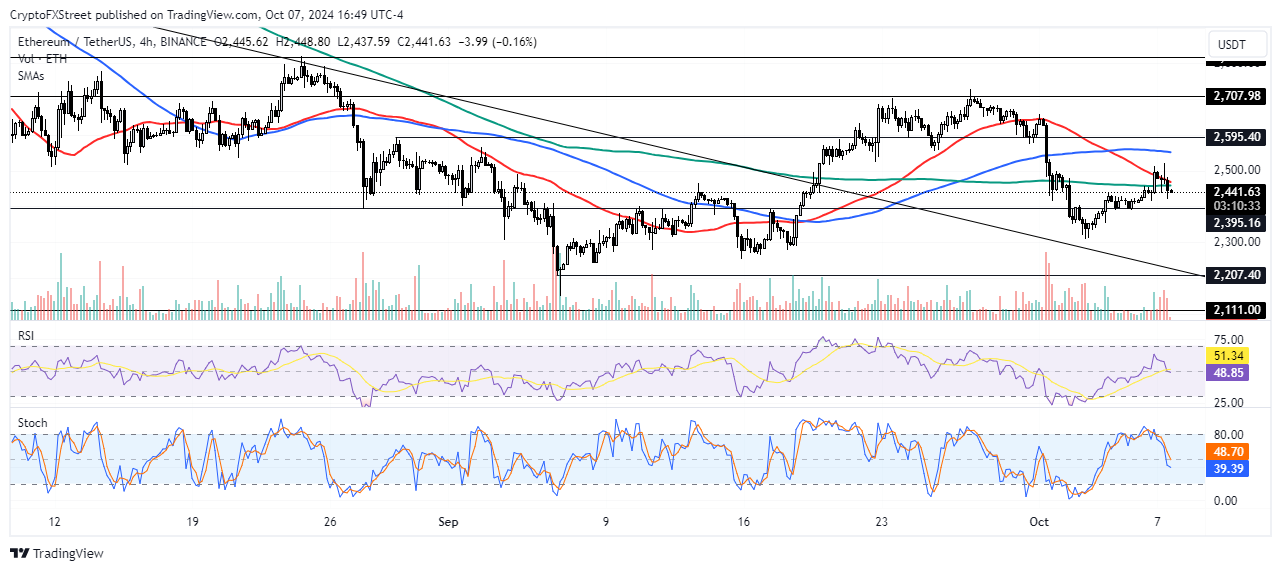Ethereum stays below $2,500 as developer proposes new EIP to boost throughput and DEX efficiency
- Ethereum will see a 50% speed increase and improved DEX efficiency if new proposal is approved.
- EIP-7781 is already getting support from key members within the Ethereum community.
- Ethereum has maintained consolidating below the $2,500 level after posting a Doji candle.
Ethereum (ETH) is up slightly by 0.1% on Monday following the appearance of a Doji candle, indicating a potential reversal in price trend. The potential price change follows a new Ethereum Improvement Proposal (EIP) EIP-7781, which aims to reduce slot time and boost the network's speed by roughly 50%.
Ethereum's new proposal to boost throughput and DEX efficiency
The new EIP-7781, initially proposed by Illyriad Games co-founder Ben Adams, aims to boost Ethereum's throughput by 33% through a process that will see slot time fall from 12 seconds to 8 seconds. Slot times are intervals during which validators propose new blocks to the Ethereum network.
The decrease in slot time also implies a reduction in based rollup latency. Based rollups are a new type of rollup that leverages the main chain for transaction sequencing as opposed to optimistic and ZK rollups.
The changes also imply an increase in blob — a data structure for storing L2 transactions introduced in the March Dencun — count from 6 to 8 or a hike in the gas limit from 30M to 40M.
There's a new EIP to increase Ethereum's throughput by 50%.
— cygaar (@0xCygaar) October 6, 2024
- 12 second block times -> 8 seconds
- 6 data blobs per block -> 9 blobs per block
- DEXes become around 1.22x more efficient
If approved, this would be a huge first step in improving Ethereum L1's performance. pic.twitter.com/MkX5gbiBFR
EIP-7781 is already getting support from key members within the crypto community, including Ethereum researcher Justin Drake, who said the proposal will improve speed by 50% and make decentralized exchanges like Uniswap v3 1.22x more efficient. Such efficiency could translate to $100M saved from the price discrepancies arbitrageurs profit from, "ultimately leading to a better execution for users."
While many have raised concerns about the potential hardware requirements from implementing the proposal, Adams noted that it could achieve these benefits without increasing the peak bandwidth.
EIP-7781 will go through the governance voting process of Ethereum before developers can take the next step toward its implementation.
Meanwhile, Ethereum ETFs globally posted a net outflow of $29 million last week, per CoinShares data.
Ethereum consolidates below $2,500 level following key indecision candle
Ethereum is trading around $2,450 on Monday, slightly up on the day. The top altcoin has sustained liquidations worth nearly $57 million in the past 24 hours, with long and short liquidations accounting for $41.23 million and $15.75 million, respectively.
ETH is consolidating within a key rectangle channel after it saw a rejection around the $2,500 psychological level, posting a Doji candle on the 4-hour chart.

ETH/USDT 4-hour chart
Doji candles are formed when an asset's open and closing prices are almost the same. The candle represents indecision among traders and could signify a potential trend reversal. As a result, ETH could see a brief decline toward the support near $2,395.
The bearish move is supported by prices crossing below the convergence of the 50-day and 100-day Simple Moving Averages (SMA) near $2,470
The Relative Strength Index (RSI) and Stochastic Oscillator (Stoch) momentum indicators are slightly below their neutral levels, indicating bearish momentum among traders.
A daily candlestick close below $2,395 will invalidate the thesis.
Ethereum FAQs
Ethereum is a decentralized open-source blockchain with smart contracts functionality. Its native currency Ether (ETH), is the second-largest cryptocurrency and number one altcoin by market capitalization. The Ethereum network is tailored for building crypto solutions like decentralized finance (DeFi), GameFi, non-fungible tokens (NFTs), decentralized autonomous organizations (DAOs), etc.
Ethereum is a public decentralized blockchain technology, where developers can build and deploy applications that function without the need for a central authority. To make this easier, the network leverages the Solidity programming language and Ethereum virtual machine which helps developers create and launch applications with smart contract functionality.
Smart contracts are publicly verifiable codes that automates agreements between two or more parties. Basically, these codes self-execute encoded actions when predetermined conditions are met.
Staking is a process of earning yield on your idle crypto assets by locking them in a crypto protocol for a specified duration as a means of contributing to its security. Ethereum transitioned from a Proof-of-Work (PoW) to a Proof-of-Stake (PoS) consensus mechanism on September 15, 2022, in an event christened “The Merge.” The Merge was a key part of Ethereum's roadmap to achieve high-level scalability, decentralization and security while remaining sustainable. Unlike PoW, which requires the use of expensive hardware, PoS reduces the barrier of entry for validators by leveraging the use of crypto tokens as the core foundation of its consensus process.
Gas is the unit for measuring transaction fees that users pay for conducting transactions on Ethereum. During periods of network congestion, gas can be extremely high, causing validators to prioritize transactions based on their fees.

